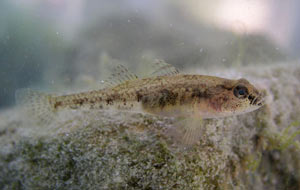 W
WKnipowitschia panizzae, the Adriatic dwarf goby, is a species of goby native to the coasts of the Adriatic and Ionian Seas where it has been recorded in Italy, Slovenia and Croatia with records from Greece needing to be confirmed. It prefers fresh and brackish waters with plentiful vegetation. This species can reach a length of 5.5 centimetres (2.2 in) TL. It is not known who the specific name honours but it is thought likely to be the Italian anatomist Bartolomeo Panizza (1785-1867), who studied the post-reproductive mortality of male sea lampreys.
 W
WAlburnus arborella is a species of ray-finned fish in the carp family Cyprinidae. It is a freshwater fish occurring in lakes and streams in Europe. It is distributed in Croatia, Italy, Slovenia, and Switzerland.
 W
WAuchenionchus crinitus is a species of labrisomid blenny endemic to the Pacific waters off of Chile.
 W
WAulostomus maculatus, the trumpetfish which is also known as the West Atlantic trumpetfish, is a long-bodied fish with an upturned mouth; it often swims vertically while trying to blend with vertical coral, such as sea rods, sea pens, and pipe sponges.
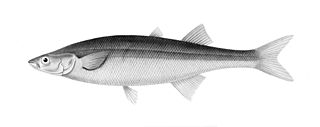 W
WBasilichthys microlepidotus is a species of Neotropical silverside endemic to Chile. It s a pelagic freshwater species which occurs from the Huasco River to Valparaiso.
 W
WThe Bennett's stingray or frilltailed stingray is a little-known species of stingray in the family Dasyatidae, with a wide but ill-defined distribution in the Indian and Pacific Oceans. This species is characterized by a rhomboid, yellow-brown pectoral fin disc with a fairly long snout, and an extremely long tail with a correspondingly long ventral fin fold. It measures up to 50 cm (20 in) across. It feeds on fish, and is aplacental viviparous. It is likely caught by demersal fisheries, but the International Union for Conservation of Nature (IUCN) does not yet have sufficient information to assess its conservation status.
 W
WThe Burchell's redfin, also known as Tradouw redfin, Tradou redfin or the Breede redfin, is an African freshwater fish species in the family Cyprinidae. P. burchelli is the type species of its genus Pseudobarbus, and like all of these is tetraploid. The Berg River redfin is a very close relative.
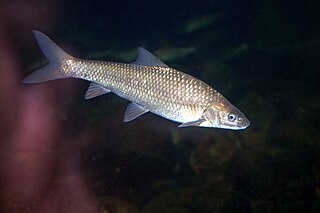 W
WThe Cape whitefish or Berg-breede River whitefish is a ray-finned fish species in the family Cyprinidae. It is placed with the South African redfins in Pseudobarbus. It is tetraploid. Its closest living relative was at one time considered the sawfin.
 W
WThe central mudminnow is a small fish in the family Umbridae of the order Esociformes. It is found in central and eastern North America in productive waters. It is fairly tolerant of low oxygen concentrations and, as a result, it is sometimes the only, or one of a very few, fish species present in waters susceptible to winter or summer kill.
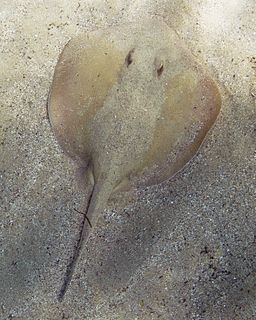 W
WThe common stingaree is a species of stingray in the family Urolophidae. The most abundant ray in inshore waters off eastern Australia, it generally inhabits estuaries, sandy flats, and rocky reefs from the shore to a depth of 60 m (200 ft). This plain brownish to grayish species has a rounded pectoral fin disc with a broadly triangular snout. Its nostrils have enlarged lobes on their outer margins and a skirt-shaped curtain of skin with a fringed posterior margin between them. Its tail bears a small dorsal fin before the stinging spine, and terminates in a leaf-shaped caudal fin. This ray can grow to 52 cm (20 in) long.
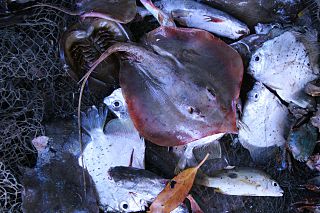 W
WBrevitrygon walga, the dwarf whipray or mangrove whipray, is a small stingray, a cartilaginous fish in the family Dasyatidae. It is a demersal fish and is found over the continental and insular shelf of the west central Pacific Ocean where it is heavily fished. The IUCN has assessed it as being "near-threatened".
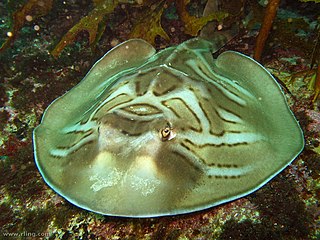 W
WThe eastern fiddler ray, also called the banjo shark, fiddler ray, fiddler, green skate, magpie fiddler ray, parrit, southern fiddler ray or southern fiddler, is a species of fish in the Rhinobatidae family. It is endemic to eastern Australia. Its natural habitat is open seas.
 W
WThe flapnose ray or Javanese cownose ray is a species of fish in the family Rhinopteridae. It is found in the Indo-Pacific off China, India, Indonesia, Iran, Japan, Madagascar, Malaysia, Mozambique, Pakistan, the Philippines, Seychelles, Somalia, South Africa, Sri Lanka, Taiwan, Tanzania, Thailand, Vietnam and possibly Australia. Its natural habitats are open seas, shallow seas, subtidal aquatic beds, coral reefs, estuarine waters, and coastal saline lagoons.
 W
WThe greenback horse mackerel or greenback scad is a species of jack in the family Carangidae, found around western and southern Australia, and around New Zealand, from the surface to depths of 460 m. Its length is up to 64 cm.
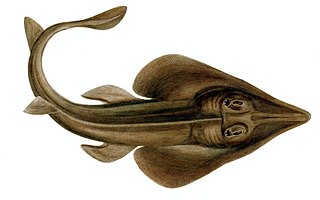 W
WThe Brazilian guitarfish is a species of fish in the family Rhinobatidae. It is endemic to Brazil, where its natural habitat is coastal waters on the continental shelf. This fish is viviparous and has a long gestation period, concluding with the birth of live pups in February. At this time the fish are subject to intense fishing activity but catches have been dwindling in recent years as a result of overfishing. Because so few breeding-size fish remain, the International Union for Conservation of Nature has assessed the fish's conservation status as being "critically endangered".
 W
WHydrolycus armatus is a species of dogtooth characin found in freshwater of tropical South America. It is sometimes known as the payara, a name it shares with the related H. scomberoides.
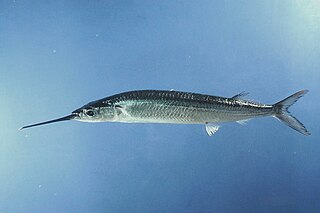 W
WHyporhamphus unifasciatus, the common halfbeak or the Atlantic silverstripe halfbeak, is a bony fish in the family Hemiramphidae. It is found in the subtropical western Atlantic Ocean and the Gulf of Mexico. It is a common fish and not used for food to any great extent, and the International Union for Conservation of Nature has listed its conservation status as being of "least concern".
 W
WThe bluespotted stingray, also known as the bluespotted maskray or Kuhl's stingray, is a species of stingray of the family Dasyatidae. It was recently changed from Dasyatis kuhlii in 2008 after morphological and molecular analyses show that it is part of a distinct genus, Neotrygon. The body is rhomboidal and colored green with blue spots. Maximum disk width is estimated 46.5 centimeters (18.3 in). It is popular in aquaria but usually not distinguished from the bluespotted ribbontail ray. The ribbontail has a rounded body, is a brighter green with brighter blue and more vivid spots, but the bluespotted stingray is larger. The stingray's lifespan is estimated thirteen years of age for females and ten years for males. The bluespotted stingray preys on many fish and small mollusks. The bluespotted stingray is also generally found from Indonesia to Japan, and most of Australia. The bluespotted stingray is also targeted by many parasites such as tapeworms, flatworms, and flukes.
 W
WThe largescale yellowfish or Lowveld largescale yellowfish is a species of fish in the family Cyprinidae. An African freshwater fish found from the Zambezi south to the Pongola River.
 W
WLeiarius arekaima, commonly as Tiger Pimelodus, is a species of benthopelagic catfish of the family Pimelodidae that is native to Guyana and Brazil.
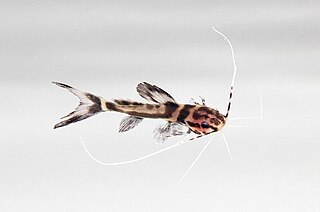 W
WLeiarius marmoratus, commonly as Sailfin Pim or Achara Catfish, is a species of demersal catfish of the family Pimelodidae that is native to Amazon and Orinoco river basins.
 W
WThe lesser guitarfish or lesser sandshark is a species of fish in the Rhinobatidae family. It is found in Angola, Namibia, South Africa, and possibly Mozambique. Its natural habitats are shallow seas and estuarine waters. It is threatened by habitat loss.
 W
WLeucos aula is a species of freshwater fish in the family Cyprinidae. It is native to the Adriatic basin in southern Europe, originally occurring in Italy, Slovenia, Croatia, and Switzerland. It has been introduced to other parts of Italy. This is an abundant fish, occurring in canals, swamps, lakes, and streams with slow current and dense vegetation.
 W
WThe jaguar catfish is a species of driftwood catfish endemic to Brazil where it is found in the Branco River. It is also found in the aquarium trade.
 W
WMoggel is a freshwater African fish in genus Labeo. It occurs within the drainage basin of the Orange River. The species has been recorded in the [Vaal], Olifants River in Mpumalanga and Limpopo, introduced there by anglers.
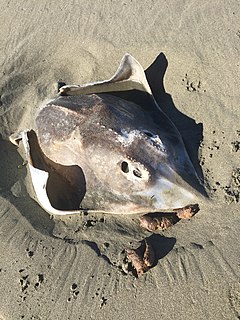 W
WThe New Zealand rough skate, Zearaja nasuta, is a skate of the genus Zearaja, found around New Zealand at depths between 10 and 1,500 m. Its length is up to 1 m. This species has been assessed by the IUCN as of Least Concern. In June 2018 the New Zealand Department of Conservation classified the New Zealand rough skate as "Not Threatened" with the qualifier "Conservation Dependant" under the New Zealand Threat Classification System.
 W
WThe ocellate river stingray, also known as the peacock-eye stingray or black river stingray, is a species of freshwater stingray in the family Potamotrygonidae. It was the first species to be described in the family and is also the most widespread, ranging throughout much of the Río de la Plata, Amazon, Mearim and Orinoco basins in tropical and subtropical South America. It is sometimes kept in aquaria.
 W
WThe ocellate spot skate, also known as the spiny rasp skate or swarthy skate, is a species of skate in the family Rajidae and is commonly found in the north-western Pacific Ocean. O. kenojei is a bottom-feeding carnivore that consumes mainly shrimp, fishes, and crabs. Its diet also includes small quantities of amphipods, mysids, cephalopods, euphausiids, copepods, isopods, and polychaetes.
 W
WOrange River Mudfish is a species of fish in genus Labeo. It inhabits the Orange River system of southern Africa.
 W
WThe pale-edged stingray or sharpnose stingray is a species of stingray in the family Dasyatidae, found in the Indian and Pacific Oceans from India to the western Malay Archipelago and southern Japan. This bottom-dwelling ray is most commonly found over sandy areas shallower than 100 m (330 ft), as well as in estuaries. Measuring up to 29 cm (11 in) across, the pale-edged stingray has a diamond-shaped pectoral fin disc, a long projecting snout, small eyes, and a whip-like tail with both dorsal and ventral fin folds. It is chocolate brown above and white below.
 W
WParatrygon is a monotypic genus of the cartilaginous fish in the family of Potamotrygonidae. The sole currently recognized species is Paratrygon aiereba, the discus ray, manzana ray or ceja ray, from the Amazon and Orinoco basins in South America. Genetic and morphometric evidence suggests that P. aiereba as presently defined is a species complex.
 W
WParatrygon is a monotypic genus of the cartilaginous fish in the family of Potamotrygonidae. The sole currently recognized species is Paratrygon aiereba, the discus ray, manzana ray or ceja ray, from the Amazon and Orinoco basins in South America. Genetic and morphometric evidence suggests that P. aiereba as presently defined is a species complex.
 W
WThe Parona leatherjacket is a species of carangid found along the Atlantic coast of South America from southern Brazil to southern Argentina and the Falkland Islands. This species grows to a length of 60 centimetres (24 in) TL and is of minor importance to local commercial fisheries. This species is the only known member of its genus.
 W
WThe Pike characin is a species of fish in the family Acestrorhynchidae. It was described by Sir William Jardine, 7th Baronet in 1841, originally under the genus Hydrocyon. It inhabits the Orinoco and Amazon Rivers in the regions of Suriname, Guyana, and French Guiana, at a pH range of 5.5-6.5. It reaches a maximum total length of 37 cm (15 in), and a maximum weight of 230 g (8.1 oz).
 W
WPlatynematichthys notatus, the coroatá or striped catfish, is a species of catfish of the monotypic genus Platynematichthys of the family Pimelodidae. It is native to the Amazon and Orinoco basins in South America. In the Orinoco this distinctly spotted species reaches up to 1 m (3.3 ft) in standard length, but it reportedly only reaches about half that size in the Amazon.
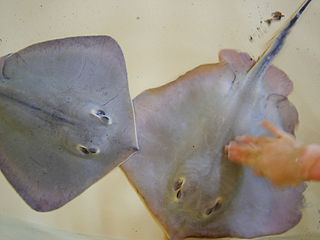 W
WThe red stingray is a species of stingray in the family Dasyatidae, found in the northwestern Pacific Ocean off Japan, Korea, and China, and possibly elsewhere. It primarily inhabits shallow, sandy habitats close to shore, and has been known to enter brackish water. The red stingray has a diamond-shaped pectoral fin disc and gains its common name from its bright orange-red underside; there may also be patches of orange at various spots on its upper surface. Most individuals are no more than 1 m (3.3 ft) long.
 W
WThe Rio skate is a shallow water skate native to the Atlantic coast of South America from Brazil to southern Argentina. It is the only member of the monotypic genus Rioraja.
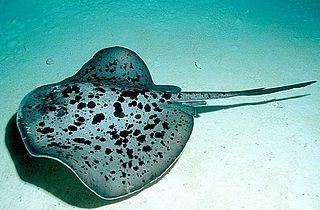 W
WThe round ribbontail ray is a species of stingray in the family Dasyatidae, found throughout the nearshore waters of the tropical Indo-Pacific, as well as off islands in the eastern Pacific. It is a bottom-dwelling inhabitant of lagoons, estuaries, and reefs, generally at a depth of 20–60 m (66–197 ft). Reaching 1.8 m (5.9 ft) across, this large ray is characterized by a thick, rounded pectoral fin disc covered by small tubercles on top, and a relatively short tail bearing a deep ventral fin fold. In addition, it has a variable but distinctive light and dark mottled pattern on its upper surface, and a black tail.
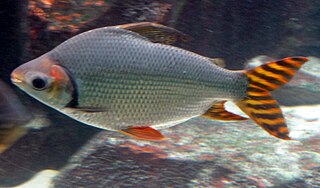 W
WThe kissing prochilodus or flag-tailed prochilodus is a species of South American freshwater fish in the family Prochilodontidae. It is native to central and western parts of the Amazon basin. It is migratory, moving in large groups into whitewater rivers to spawn, afterwards returning to blackwater and clearwater rivers, as well as flooded forests. It is important in fisheries and sometimes seen in the aquarium trade, but require a relatively large tank. It can reach a maximum standard length of 27.5 cm (10.8 in) and weight of 560 g (1.23 lb). It resembles the other members of the genus Semaprochilodus, where most species are silvery with orange-red fins and a striped tail. Adult S. insignis lack the dark flank spots that can be seen in adult S. taeniurus, but both species have these spots as juveniles.
 W
WThe sepia stingray is a species of fish in the family Urolophidae. It is found in Japan, Taiwan, Vietnam, possibly North Korea, and possibly South Korea. It is threatened by habitat loss.
 W
WThe short-finned eel, also known as the shortfin eel, is one of the 15 species of eel in the family Anguillidae. It is native to the lakes, dams and coastal rivers of south-eastern Australia, New Zealand, and much of the South Pacific, including New Caledonia, Norfolk Island, Lord Howe Island, Tahiti, and Fiji.
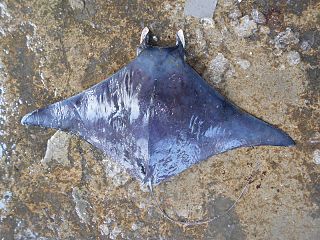 W
WThe shortfin devil ray is a species of ray in the family Mobulidae. It is endemic to the Indian Ocean and central-west Pacific Ocean. It ranges from South Africa, Mozambique, Tanzania and the Seychelles in the west to the Philippines and Indonesia in the east, and southward to the northern coast of Australia.
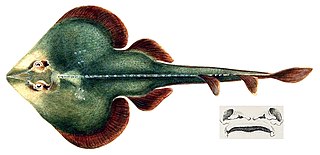 W
WThe shortnose guitarfish is a species of fish in the Rhinobatidae family found in the southwest Atlantic in coastal parts of southern Brazil, through Uruguay, to northeast Argentina. It reaches a length of 66 cm (2.17 ft).
 W
WThe smallnose fanskate is a species of fish in the family Arhynchobatidae. It is found off the coasts of Argentina, Brazil, Chile, and Uruguay. Its natural habitats are open seas, shallow seas, and estuarine waters.
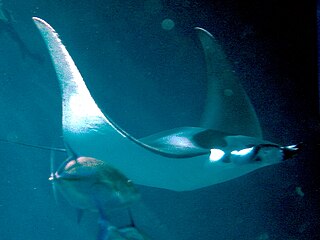 W
WThe spinetail devil ray, also known as the spinetail mobula ray or japanese mobula ray, is a species of pelagic marine fish which belongs to the family Mobulidae. It is found throughout the tropical and sub-tropical waters of the Indo-Pacific and eastern Atlantic Ocean.
 W
WThe striped panray is a species of ray in the family Zanobatidae. It was considered the only species in its genus and family until the description of the maculate panray in 2016.
 W
WThe Tasmanian numbfish is a species of electric ray in the family Narcinidae. Endemic to southeastern Australia, this common ray inhabits shallow continental shelf waters in the southern portion of its range and deeper continental slope waters in the northern portion of its range. It prefers sand and mud habitats. This species can be identified by its spade-shaped pectoral fin disc with concave anterior margins, long tail with well-developed skin folds along either side, and plain dark brown dorsal colouration. Its maximum known length is 47 cm (19 in).